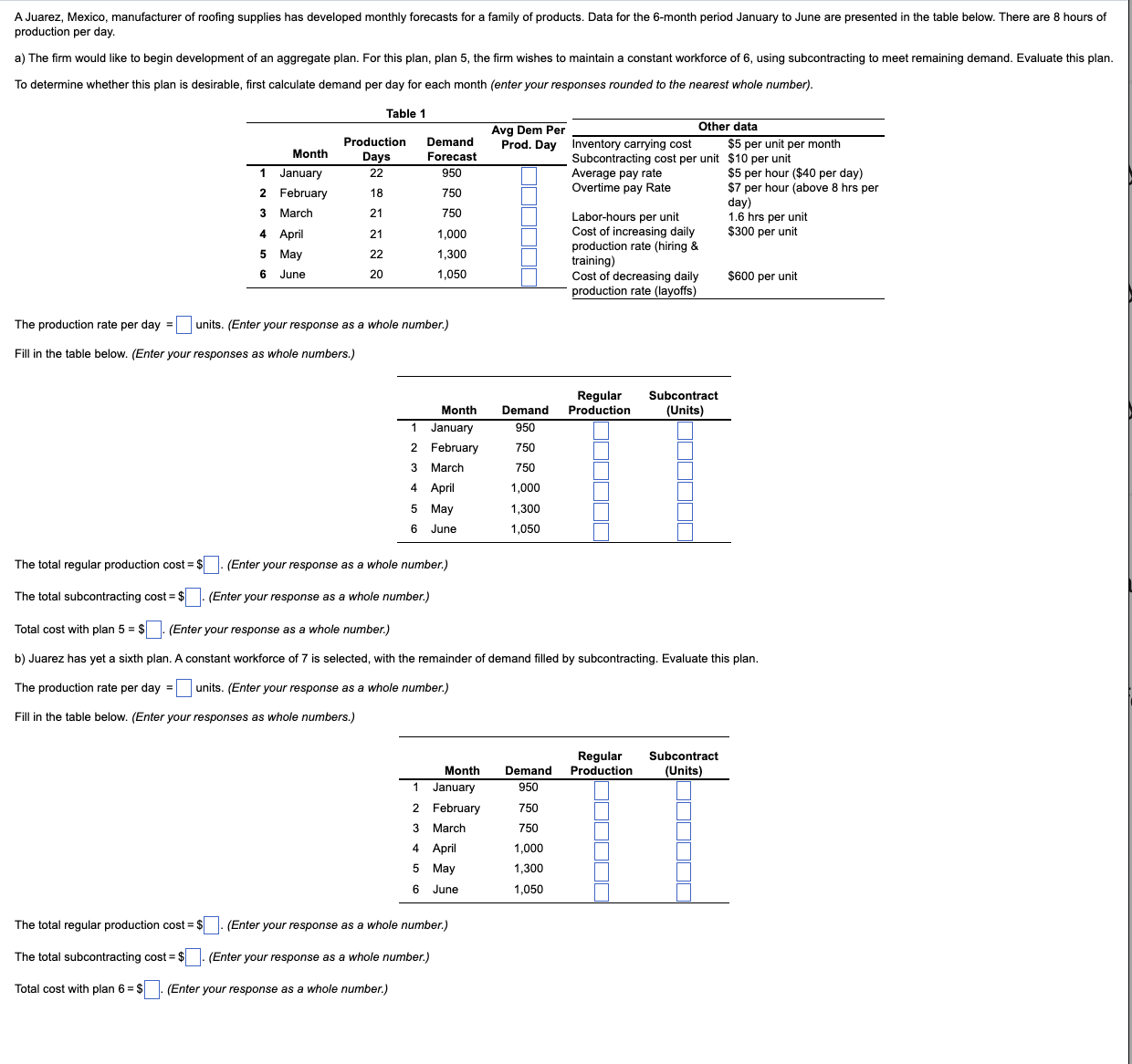Question
Question content area Part 1 A Juarez, Mexico, manufacturer of roofing supplies has developed monthly forecasts for a family of products. Data for the 6-month

Question content area
Part 1
A Juarez, Mexico, manufacturer of roofing supplies has developed monthly forecasts for a family of products. Data for the 6-month period January to June are presented in the table below. There are 8 hours of production per day.
a) The firm would like to begin development of an aggregate plan. For this plan, plan 5, the firm wishes to maintain a constant workforce of
6, using subcontracting to meet remaining demand. Evaluate this plan.
Part 2
To determine whether this plan is desirable, first calculate demand per day for each month (enter your responses rounded to the nearest whole number).
| Table 1 |
| Month | Production Days | Demand Forecast | Avg Dem Per Prod. Day | |
| 1 | January | 22 | 950 | enter your response here |
| 2 | February | 18 | 750 | enter your response here |
| 3 | March | 21 | 750 | enter your response here |
| 4 | April | 21 | 1,000 | enter your response here |
| 5 | May | 22 | 1,300 | enter your response here |
| 6 | June | 20 | 1,050 | enter your response here |
| Other data | |
| Inventory carrying cost | $
5 per unit per month |
| Subcontracting cost per unit | $
10 per unit |
| Average pay rate | $
5 per hour ($
40 per day) |
| Overtime pay Rate | $
7 per hour (above 8 hrs per day) |
| Labor-hours per unit | 1.6 hrs per unit |
| Cost of increasing daily production rate (hiring & training) | $
300 per unit |
| Cost of decreasing daily production rate (layoffs) | $
600 per unit |
Part 3
The production rate per day
=
enter your response here
units. (Enter your response as a whole number.)
Part 4
Fill in the table below. (Enter your responses as whole numbers.)
| Month | Demand | Regular Production | Subcontract (Units) | |
| 1 | January | 950 | enter your response here | enter your response here |
| 2 | February | 750 | enter your response here | enter your response here |
| 3 | March | 750 | enter your response here | enter your response here |
| 4 | April | 1,000 | enter your response here | enter your response here |
| 5 | May | 1,300 | enter your response here | enter your response here |
Part 5
The total regular production cost
=$
enter your response here
. (Enter your response as a whole number.)
Part 6
The total subcontracting cost
=$
enter your response here
. (Enter your response as a whole number.)
Part 7
Total cost with plan 5 = $
enter your response here
. (Enter your response as a whole number.)
Part 8
b) Juarez has yet a sixth plan. A constant workforce of
7 is selected, with the remainder of demand filled by subcontracting. Evaluate this plan.
Part 9
The production rate per day
=
enter your response here
units. (Enter your response as a whole number.)
Part 10
Fill in the table below. (Enter your responses as whole numbers.)
Part 11
The total regular production cost
=$
enter your response here
. (Enter your response as a whole number.)
Part 12
The total subcontracting cost
=$
enter your response here
. (Enter your response as a whole number.)
Part 13
Total cost with plan 6
=$
enter your response here
. (Enter your response as a whole number.)
production per day. To determine whether this plan is desirable, first calculate demand per day for each month (enter your responses rounded to the nearest whole number). The production rate per day = units. (Enter your response as a whole number.) Fill in the table below. (Enter your responses as whole numbers.) The total regular production cost =$. (Enter your response as a whole number.) The total subcontracting cost =$. (Enter your response as a whole number.) Total cost with plan 5=$ (Enter your response as a whole number.) b) Juarez has yet a sixth plan. A constant workforce of 7 is selected, with the remainder of demand filled by subcontracting. Evaluate this plan. The production rate per day = units. (Enter your response as a whole number.) Fill in the table below. (Enter your responses as whole numbers.) The total regular production cost =$. (Enter your response as a whole number.) The total subcontracting cost =$. (Enter your response as a whole number.) Total cost with plan 6=$ (Enter your response as a whole number.)Step by Step Solution
There are 3 Steps involved in it
Step: 1

Get Instant Access to Expert-Tailored Solutions
See step-by-step solutions with expert insights and AI powered tools for academic success
Step: 2

Step: 3

Ace Your Homework with AI
Get the answers you need in no time with our AI-driven, step-by-step assistance
Get Started


